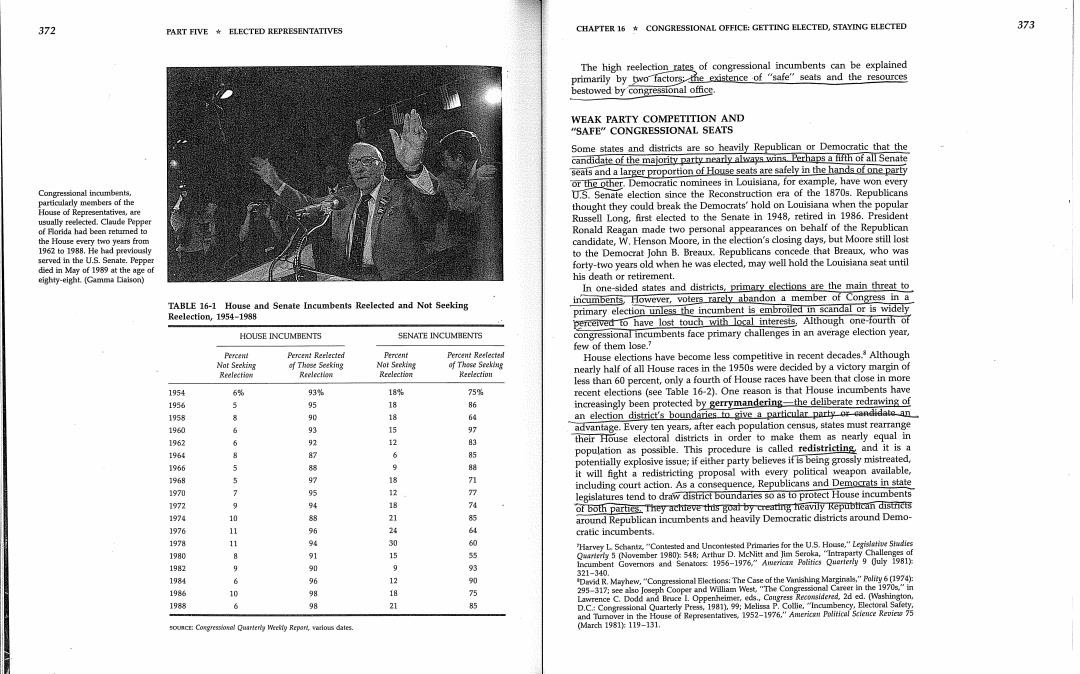正在加载图片...

372 PART FIVE★瓦.ECTED REPRESENTATIVES CHAPTER 16*CONGRESSIONAL OFFICE:GETTING ELECTED,STAYING ELECTED 373 The high reelection rates of congressional incumbents can be explained primarily by two factors;the existence of "safe"seats and the resources bestowed by congresslonal office. WEAK PARTY COMPETITION AND "SAFE"CONGRESSIONAL SEATS Some states and districts are so heavily Republican or Democratic that the candidate of the majority party nearly always wins Perhaps a lifth of all Senate seats and a larger proportion of House seats are safely in the hands of one party or the other.Democratic nominees in Louisiana,for example,have won every Con U.S.Senate election since the Reconstruction era of the 1870s.Republicans thought they could break the Democrats'hold on Louisiana when the popular House of Representatives,are usually reelected.Clmude Pepper Russell Long,first elected to the Senate in 1948,retired in 1986.President of Florida had been returned to Ronald Reagan made two personal appearances on behalf of the Republican the House every two years from candidate,W.Henson Moore,in the election's closing days,but Moore still lost 1962to1988,Hehd served in the US.Senate.Pepper to the Democrat John B.Breaux.Republicans concede.that Breaux,who was ded in May of 1989 at the age of forty-two years old when he was elected,may well hold the Louisiana seat until eighty-eight.(Gamma Ciaison) his death or retirement. In one-sided states and districts,primary elections are the main threat to TABLE 16-1 House and Senate Incumbents Reelected and Not Seeking incumbents,However,voters rarely abandon a member of Congress in a Reelection,1954-1988 primary election unless the incumbent is embroiled in scandal or is widely perceived to have lost touch with local interests,Although one-fourth of HOUSE INCUMBENTS SENATE INCUMHENTS congressional incumbents face primary challenges in an average election year, few of them lose.? Percenl Percen!Rerlected Percent Percent Reelected Not Secking of Those Seeking Not Seeking House elections have become less competitive in recent decades.3 Although of These Seeklug nearly half of all House races in the 1950s were decided by a victory margin of less than 60 percent,only a fourth of House races have been that close in more 1954 6% 93% 18% 75% recent elections (see Table 16-2).One reason is that House incumbents have 19 95 increasingly been protected by gerrymandering-the deliberate redrawing of 18e8 % 保 an election district's boundaries to give a particular party o candidate an 15 advantage.Every ten years,after each population census,states must rearrange 196 6 2 的 their House electoral districts in order to make them as nearly equal in 964 8 87 population as possible.This procedure is called redistricting and it is a I966 5 83 9 品 potentially explosive issue;if either party believes if is being grossly mistreated, 1968 5 it will fight a redistricting proposal with every political weapon available, 1970 including court action.As a consequence,Republicans and Democrats in state legislatures tend to draw district boundaries so as to protect House incumbents 9 94 8 合 1974 of both parties.They achieve this goal by creating heavily Republlean distncts 88 85 around Republican incumbents and heavily Democratic districts around Demo- 1976 24 6 cratic incumbents. 1978 1 94 Harvey L Schantz"Contested and Uncontested Primares for the U.S.House,"LegisSdic 9 159 y5(November 1980548:Arthur D.McNitt and Jim Ser 1984 96 12 a 321-340. Dvid R.Mayhew,"Congressional Elections:The Case of the Vanishin 1986 98 18 75 295-317:see also Joseph Cooper and William West,"The Congress Lawrence C.Dodd and Bruce I.Oppenheim 1988 98 21 85 Cougress 6 D.C.:Congressional Quarterly Press,1981).99 and Tumover in the House of Representatives,1952- -1976 March1981y119-131